Japanese Lessons
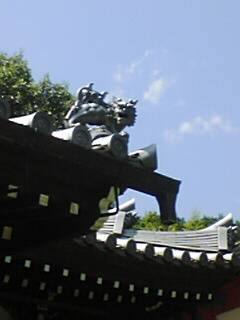
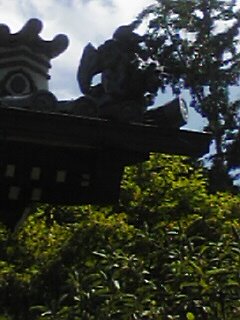
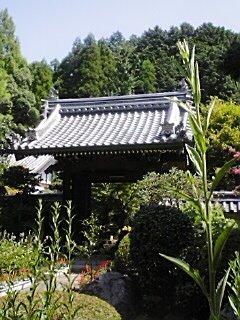


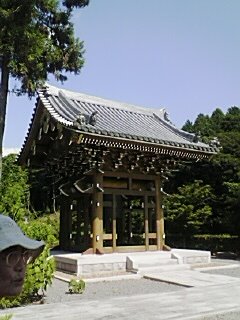
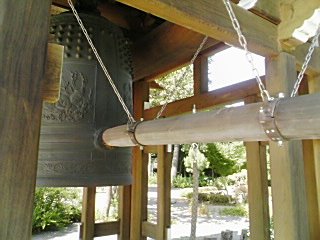
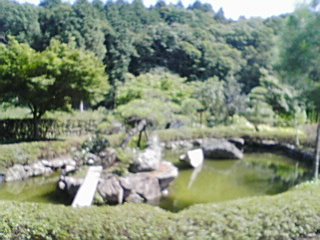
My Japanese teacher, Nishi-sensei ("Professor West") took me to Kongoo Ji, a Buddist shrine yesterday. There, they have assortments of gigantic statues as guardians along the now-paved roads and along the foot-paths through
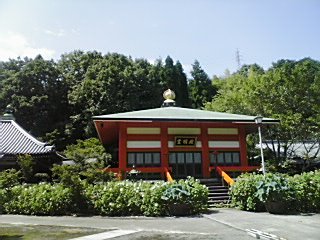 park. Nothing is readily handicap-accessible. Like with many doorways in Japan, the bottom of the doorways are proportionally higher as the door gets bigger. So in my home there is a 1-3 in. bump between rooms, but in the big gates at Kongoo, you have to step over a huge B much of theEAM to walk trough some of the doors. Feels strange, but, the gates are so beautiful you don't care (unless you have crutches or a wheelchair). The roofs are lined along the edges with a symbol of one of the more dominant
park. Nothing is readily handicap-accessible. Like with many doorways in Japan, the bottom of the doorways are proportionally higher as the door gets bigger. So in my home there is a 1-3 in. bump between rooms, but in the big gates at Kongoo, you have to step over a huge B much of theEAM to walk trough some of the doors. Feels strange, but, the gates are so beautiful you don't care (unless you have crutches or a wheelchair). The roofs are lined along the edges with a symbol of one of the more dominant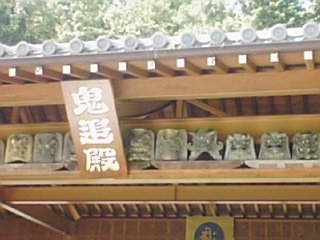

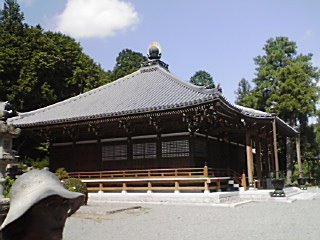 samurai clans, looking like a yin-yang, but with 3 of the "fishies" chasing around (you can see it in some of the pictures at the circular ends of the roof-tiles). This monastery obviously had some samurai influence in the past! Also, something you won't see in the rest of the Buddist world, are Inu,
samurai clans, looking like a yin-yang, but with 3 of the "fishies" chasing around (you can see it in some of the pictures at the circular ends of the roof-tiles). This monastery obviously had some samurai influence in the past! Also, something you won't see in the rest of the Buddist world, are Inu, 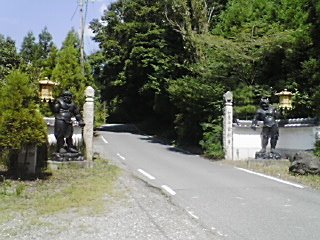 croutching on the lips of
croutching on the lips of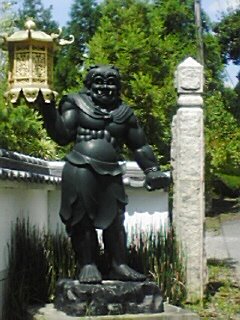 most roofs, and hanging along the beams of the inside of buildings. These are strone demons. They leave both a sense of awe and a sense of "keep in line, you're in a monastery." A
most roofs, and hanging along the beams of the inside of buildings. These are strone demons. They leave both a sense of awe and a sense of "keep in line, you're in a monastery." A lso, there were two slightly more amazing statues present: one's for prayer. The one with the
lso, there were two slightly more amazing statues present: one's for prayer. The one with the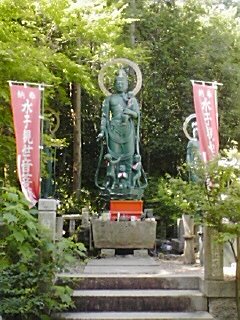 children at the feet is used to pray for mothers whose child did not come to term, "suiko" (sounds like "water-child" to me, but I don't think that is accurate either, since the prayers aren't for the embryos but for the mothers only
children at the feet is used to pray for mothers whose child did not come to term, "suiko" (sounds like "water-child" to me, but I don't think that is accurate either, since the prayers aren't for the embryos but for the mothers only 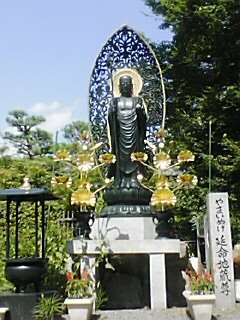 at this shrine.) The other one has a clearly labels granite spire next to it, stating "illness can be relieved by prayer here" (in a much more poetic form). I passed through a giant cemetery with beautiful, well-kept grave cites (almost all Japanese-Buddist in style) and I caught sight of some giant black fish swimming along the cute and narrow streams that run throughout the place causing it to be split by a variety of small bridges. People say fish only grow as big as their residence but...these fish were about as tall as they could be without their fins being out of the water!
at this shrine.) The other one has a clearly labels granite spire next to it, stating "illness can be relieved by prayer here" (in a much more poetic form). I passed through a giant cemetery with beautiful, well-kept grave cites (almost all Japanese-Buddist in style) and I caught sight of some giant black fish swimming along the cute and narrow streams that run throughout the place causing it to be split by a variety of small bridges. People say fish only grow as big as their residence but...these fish were about as tall as they could be without their fins being out of the water!There were also spiders and spiderwebs everywhere. some of the spiders made ours look quite tame, and apparenty some can jump long distances, since I saw some strings of web that crossed lengths of around a few yards or meters. When I asked Nishi-sensei about these, she told me that they were not at all dangerous, and, as usual, I was slightly sceptical. I'm not used to any spider being completely harmless, and many of them being deadly! He there are an assortment of the buggers of the nastiest-looking varieties you've ever seen, and they are harmless? Well, eventually I'll believe it whole-heartedly, but I can't help but be wary for now. I also obtained a few pictures.
Before we left, Nishi-sensei had me go up to the large bell you see encased in a roofed frame. It is huge! You ring it with a big log on a rope, which you pull back and let it swing forward. It is a low, peaceful sound, that rings for about 2 minutes audibly before dropping off the end of your hearing range. What a wonderful sound...it makes clock chimes and most big American bells sound brash and irritating by comparison...then again, many people seem to think Americans are brash and irritating!
You know how a good used book store can make you happy? Well, I found one that redefines "happy" in connection to "bookstore." It is called Book Off. The average price of a book in Book Off is about 100 yen (roughly 90 cents) and is untaxed. I can find mint condition series of manga for 3000 Yen, about 26ish dollars. Thats 35 books! I can find about 100 differerent popular series and probably just as many that are otherwise. They also sell used video games. I found a game that is perhaps $60-100 for the equivalent of $4.50. Anyone who needs any Japanese literature, manga, or maybe Anime can ask, and they can pay me back. (However, anime is expensive anywhere, and never translated in Japanese version, which Japanese English teachers get very mad about when they want to use movies they KNOW are translated for OTHER countries.)
Another thing, and this is an apology. I apologize if I made the Japanese style of teacher or subborness/resilence of many of the older teachers sound bad. There are definitely things that the Japanese education system do work well for, such and Math and Science. However, teaching methodology for almost any subject is almost identical for any subject for any older (and influential) teacher. Their preferences are exerted on the rest of the younger groups of teachers, and even the teachers that want to change sometimes do not have the option. Some of the older that want to change would lose great dignity at their own style changing late in their lives. It would be admitting that their forebearers were in some way inferior to people alive and teaching today, instead of superior and equal. It is too bad, and it is to some degree an internal struggle with no answer for many older teachers. I feel great empathy for them. There is no easy answer. But when most of these teachers retire, make no mistake about it, the system is able to move more easily toward language-teaching specific techniques, towards ability to use speech, to use language in the classroom, to have individualities in their English, to develop accent, and to learn to use English in the sense of it being "living English," the clearly stated official and well-known goal of the Ministry of Education for the past 20 years. But if the teachers can't speak it because their teachers were like themselves, the students won't speak it. And if the students grow up not speaking it, they will not be able to teach speaking to their students. This cycle has already started, but luckily there are some progressive teachers making ground. However, there is a problem that happens: once they get some power to make changes (through an institution) this comes with increased status. The higher the status, the less the freedom. And no matter how high you go, there is always someone above you, usually unbudgable and to whom which you are to defer. Therefore, most people like myself have to cut back on the new and the techniques that they know are different but in many cases more helpful for achieving national goals and go with what their superiors want. However, when the going gets rough, most teachers, despite wanting group conformity more than global change, will stay at their post in the hardest times, with bad pay, little vacation, and the stress of being their children's Mama or Papa. This is nothing short of the most admirable. Most teachers in Japan would rather have a job more like that of what many of teachers in America would probably leave within a year. So this "weak-point" in progress is also a strong point in character. They gamman, or persevere, as a part of self-discipline. Some might see it as foolhardy, but to most here, and to myself, that ability to gamman is quite admirable. I know that Teachers here deep down wants the best for their students, and that most really do want to change, to varying degrees. It's just not always possible within the bounds of the system. In America this would leave us feeling "powerless," which is awful for us. Here, however, it leaves people with a sense of amae, that is, of dependence, almost like interdependence but with more heirarchy. This is seen as a good thing to have here. It fits well with the Taoist idea of balance, and the Shinto belief that one should find comfort in harmony with your surroundings and strive for peace with Earth and with others. So it definitely isn't all bad with teachers here, and in some ways, we could take some serious lessons from Japanese teachers as much as they could of us.

1 Comments:
Wow, that place looks beautifull. I always wondered what thoes shrines actually looked like.
Post a Comment
<< Home